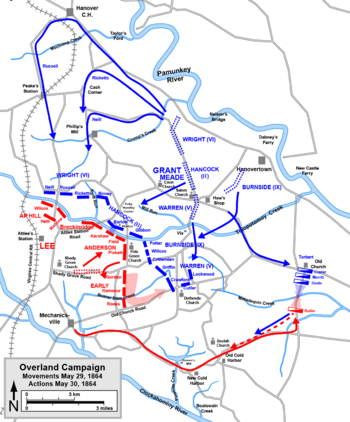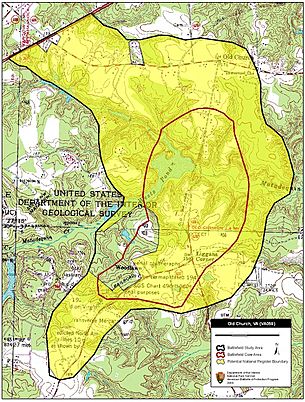Battle of Old Church facts for kids
Quick facts for kids Battle of Old Church |
|||||||
|---|---|---|---|---|---|---|---|
| Part of the American Civil War | |||||||
 Union cavalry horses photographed outside the Old Church Hotel by Timothy H. O'Sullivan, June 4, 1864 |
|||||||
|
|||||||
| Belligerents | |||||||
| Commanders and leaders | |||||||
| Alfred T. A. Torbert | Matthew C. Butler | ||||||
| Strength | |||||||
| 1 division | 2,000 (1 brigade) | ||||||
| Casualties and losses | |||||||
| 90 | 188 | ||||||
The Battle of Old Church, also known as Matadequin Creek, was a fight during the American Civil War. It happened on May 30, 1864. This battle was part of a larger plan called the Overland Campaign. In this campaign, Union Army leader Ulysses S. Grant was trying to defeat Confederate General Robert E. Lee and his Army of Northern Virginia.
During this battle, Union cavalry (soldiers on horseback) led by Alfred Thomas Archimedes Torbert clashed with Confederate cavalry led by Matthew C. Butler. The fight happened near Matadequin Creek and the Old Church crossroads. Even though the Confederates were outnumbered, they fought bravely. After a tough fight, the Confederates were pushed back. This Union victory helped them capture the important Old Cold Harbor crossroads the very next day.
Why the Battle Happened

While the main armies were fighting at the Battle of Bethesda Church, Union General Gouverneur K. Warren asked for help. He was worried his troops were too far ahead and might be attacked. General Philip Sheridan, who led the Union cavalry, was asked to send help.
Sheridan's cavalry was camped near the Haw's Shop battlefield. Their job was to protect the roads. These roads led to a supply base and a ferry, which were important for getting supplies and new soldiers. Sheridan eventually agreed to help Warren. He told General Alfred Thomas Archimedes Torbert to send his cavalry division to patrol the roads. Torbert then gave the job to Colonel Thomas Devin.
However, the instructions got a bit mixed up. Instead of patrolling the road Warren wanted, Devin thought he should guard a different road. He set up his soldiers in a good spot by Matadequin Creek. He also sent a small group of soldiers ahead to a farm south of the creek.
At the same time, Confederate General Robert E. Lee was worried about the important crossroads at Old Cold Harbor. This spot was only six miles from the Confederate capital, Richmond. So, he sent General Matthew C. Butler and about 2,000 cavalry soldiers to check if the area was safe. Butler's troops arrived near the farm between 1 and 2 p.m.
The Battle Begins
Butler's soldiers quickly pushed back the small group of Union soldiers at the farm. The Union soldiers fell back to Matadequin Creek. Colonel Devin sent more soldiers to help, and they managed to push the Confederates back to the original line. Devin thought he was only facing a small group of Confederates, so he didn't send more help right away.
But at 3 p.m., Butler's main force attacked. They overwhelmed the Union soldiers, who fought hard to stop the Confederates from crossing the creek. Devin then sent two more regiments (groups of soldiers) to help.
Butler placed his soldiers on both sides of the road. He kept one regiment, the 7th South Carolina, in reserve.
As General Torbert saw what was happening, he realized that three regiments were not enough. He ordered the rest of his division to move up. General Wesley Merritt's soldiers arrived first. His 2nd U.S. Cavalry Regiment took the place of the 17th Pennsylvania, which was running low on ammunition.
On the right side of the Union line, the 6th New York and 2nd U.S. soldiers pushed back the 4th South Carolina. The Confederates quickly built small walls out of logs for protection. On the left side, the 9th New York faced strong resistance from the 5th South Carolina. These Confederates were protected by the high banks of the Matadequin Creek. Merritt tried to go around the Confederate position, but his soldiers were stopped in close-up, hand-to-hand fighting.
Union Victory
The battle changed when General George Armstrong Custer and his Michigan Brigade arrived. Custer sent his soldiers to attack the Confederates from both sides. As Butler's men started to run away, his reserve regiment, the 7th South Carolina, tried to fight back.
But the Union forces had more soldiers and better weapons. Custer's Michigan soldiers had Spencer repeating rifles, which could fire many shots quickly. The Union also had horse artillery (cannons pulled by horses), which Butler did not have. These advantages helped the Union win the day.
Even though most of the fighting was done on foot, some Confederate officers bravely led charges on horseback. They were badly wounded. The Union soldiers chased the retreating Confederates. Butler eventually managed to gather his men at Old Cold Harbor. Torbert's men camped about 1.5 miles away.
What Happened Next
General Butler did get the information General Lee needed. But this was the second time in three days that the Confederate cavalry had been pushed back by the Union cavalry. In both battles, Custer's brigade was key to the Union victory.
The Union had about 90 soldiers wounded or killed, while the Confederates had about 188. This battle cleared the way for Sheridan to capture the important Old Cold Harbor crossroads the next day. This led to the start of the very bloody Battle of Cold Harbor.


